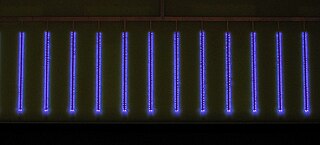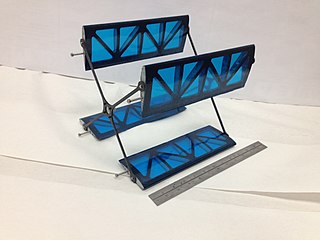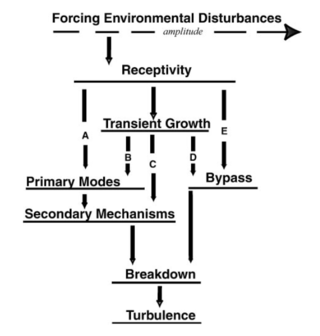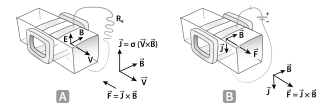
The serpentine plasma actuator represents a broad class of plasma actuator. The actuators vary from the standard type in that their electrode geometry has been modified in to be periodic across its span. [1] [2]

The serpentine plasma actuator represents a broad class of plasma actuator. The actuators vary from the standard type in that their electrode geometry has been modified in to be periodic across its span. [1] [2]
This class of plasma actuators was developed at the Applied Physics Research Group (APRG) at the University of Florida in 2008 by Subrata Roy for the purpose of controlling laminar and turbulent boundary layer flows. Since then, APRG has continued to characterize and develop uses for this class of plasma actuators. Several patents resulted from the early work on serpentine geometry plasma actuators. [3] [4] [5] [6] [7]
In 2013, these actuators started to get broader attention in the scientific press, and several articles were written about these actuators, including articles in AIP's EurekAlert, [8] Inside Science [9] and various blogs. [10] [11]

Serpentine plasma actuators (like other Dielectric Barrier Discharge actuators, i.e. plasma actuators) are able to induce an atmospheric plasma and introduce an electrohydrodynamic body force to a fluid. This body force can be used to implement flow control, and there are a range of potential applications, including drag reduction for aircraft and flow stabilization in combustion chambers. [12]

The important distinction between serpentine plasma actuators and more traditional geometries is that the geometry of the electrodes has been modified in order to be periodic across its span. As the electrode has been made periodic, the resulting plasma and body force are also spanwise periodic. With this spanwise periodicity, three-dimensional flow effects can be induced in the flow, which cannot be done with more traditional plasma actuator geometries.
It is thought that the introduction of three-dimensional flow effects allow for the plasma actuators to apply much greater levels of control authority as they allow for the plasma actuators to project onto a greater range of physical mechanisms (such as boundary layer streaks [13] or secondary instabilities of the Tollmien-Schlichting wave). Recent work indicate that these plasma actuators may have a significant impact on controlling laminar and transitional flows on a flat plate. [14] [15] In addition, the serpentine actuator has been experimentally demonstrated to increase lift, decrease drag and generate controlling rolling moments when applied to aircraft wing geometries. [16]
With the greater level of control authority that these plasma actuators may potentially possess, there is currently research being performed at several labs in the United States [17] [18] and in the United Kingdom [19] looking to apply these actuators for real world applications. Recent numerical work predicted significant turbulent drag reduction by collocating serpentine plasma actuators in a pattern to modify energetic modes of transitional flow. [20]

In physics, physical chemistry and engineering, fluid dynamics is a subdiscipline of fluid mechanics that describes the flow of fluids—liquids and gases. It has several subdisciplines, including aerodynamics and hydrodynamics. Fluid dynamics has a wide range of applications, including calculating forces and moments on aircraft, determining the mass flow rate of petroleum through pipelines, predicting weather patterns, understanding nebulae in interstellar space and modelling fission weapon detonation.

When a fluid flows around an object, the fluid exerts a force on the object. Lift is the component of this force that is perpendicular to the oncoming flow direction. It contrasts with the drag force, which is the component of the force parallel to the flow direction. Lift conventionally acts in an upward direction in order to counter the force of gravity, but it is defined to act perpendicular to the flow and therefore can act in any direction.

A magnetohydrodynamic drive or MHD accelerator is a method for propelling vehicles using only electric and magnetic fields with no moving parts, accelerating an electrically conductive propellant with magnetohydrodynamics. The fluid is directed to the rear and as a reaction, the vehicle accelerates forward.

Computational fluid dynamics (CFD) is a branch of fluid mechanics that uses numerical analysis and data structures to analyze and solve problems that involve fluid flows. Computers are used to perform the calculations required to simulate the free-stream flow of the fluid, and the interaction of the fluid with surfaces defined by boundary conditions. With high-speed supercomputers, better solutions can be achieved, and are often required to solve the largest and most complex problems. Ongoing research yields software that improves the accuracy and speed of complex simulation scenarios such as transonic or turbulent flows. Initial validation of such software is typically performed using experimental apparatus such as wind tunnels. In addition, previously performed analytical or empirical analysis of a particular problem can be used for comparison. A final validation is often performed using full-scale testing, such as flight tests.
An ion-propelled aircraft or ionocraft is an aircraft that uses electrohydrodynamics (EHD) to provide lift or thrust in the air without requiring combustion or moving parts. Current designs do not produce sufficient thrust for manned flight or useful loads.
A magnetohydrodynamic generator is a magnetohydrodynamic converter that transforms thermal energy and kinetic energy directly into electricity. An MHD generator, like a conventional generator, relies on moving a conductor through a magnetic field to generate electric current. The MHD generator uses hot conductive ionized gas as the moving conductor. The mechanical dynamo, in contrast, uses the motion of mechanical devices to accomplish this.

The Gurney flap is a small tab projecting from the trailing edge of a wing. Typically it is set at a right angle to the pressure-side surface of the airfoil and projects 1% to 2% of the wing chord. This trailing edge device can improve the performance of a simple airfoil to nearly the same level as a complex high-performance design.

In dynamical systems, intermittency is the irregular alternation of phases of apparently periodic and chaotic dynamics, or different forms of chaotic dynamics.

The Wingless Electromagnetic Air Vehicle (WEAV) is a heavier than air flight system developed at the University of Florida, funded by the Air Force Office of Scientific Research. The WEAV was invented in 2006 by Dr. Subrata Roy, plasma physicist, aerospace engineering professor at the University of Florida, and has been a subject of several patents. The WEAV employs no moving parts, and combines the aircraft structure, propulsion, energy production and storage, and control subsystems into one integrated system.

In fluid dynamics, the process of a laminar flow becoming turbulent is known as laminar–turbulent transition. The main parameter characterizing transition is the Reynolds number.

Plasma actuators are a type of actuator currently being developed for aerodynamic flow control. Plasma actuators impart force in a similar way to ionocraft. Plasma flows control has drawn considerable attention and been used in boundary layer acceleration, airfoil separation control, forebody separation control, turbine blade separation control, axial compressor stability extension, heat transfer and high-speed jet control.

Gamma-Re (γ-Re) transition model is a two equation model used in Computational Fluid Dynamics (CFD) to modify turbulent transport equations to simulate laminar, laminar-to-turbulent and turbulence states in a fluid flow. The Gamma-Re model does not intend to model the physics of the problem but attempts to fit a wide range of experiments and transition methods into its formulation. The transition model calculated an intermittency factor that creates turbulence by slowly introducing turbulent production at the laminar-to-turbulent transition location.
Dwight Barkley is a professor of mathematics at the University of Warwick.

A cyclorotor, cycloidal rotor, cycloidal propeller or cyclogiro, is a fluid propulsion device that converts shaft power into the acceleration of a fluid using a rotating axis perpendicular to the direction of fluid motion. It uses several blades with a spanwise axis parallel to the axis of rotation and perpendicular to the direction of fluid motion. These blades are cyclically pitched twice per revolution to produce force in any direction normal to the axis of rotation. Cyclorotors are used for propulsion, lift, and control on air and water vehicles. An aircraft using cyclorotors as the primary source of lift, propulsion, and control is known as a cyclogyro or cyclocopter. A unique aspect is that it can change the magnitude and direction of thrust without the need of tilting any aircraft structures. The patented application, used on ships with particular actuation mechanisms both mechanical or hydraulic, is named after German company Voith Turbo.
Mujeeb R. Malik is a Pakistani born American aerospace engineer serving as Senior Aerodynamicist at NASA Langley Research Center. He is known for his research in boundary layer stability, laminar-turbulent transition, computational methods and aerodynamic simulations. He was the architect of CFD Vision 2030, a NASA-sponsored study to advance the state-of-the-art of computational fluid dynamics (CFD) by exploiting high performance computing and modern validation experiments.

The MARHy Hypersonic low density Wind Tunnel, located at the ICARE Laboratory in Orléans, France, is a research facility used extensively for fundamental and applied research of fluid dynamic phenomena in rarefied compressible flows. Its name is an acronym for Mach Adaptable Rarefied Hypersonic, and the wind tunnel is recorded under this name in the European portal MERIL.

A bypass transition is a laminar–turbulent transition in a fluid flow over a surface. It occurs when a laminar boundary layer transitions to a turbulent one through some secondary instability mode, bypassing some of the pre-transitional events that typically occur in a natural laminar–turbulent transition.

A magnetohydrodynamic converter is an electromagnetic machine with no moving parts involving magnetohydrodynamics, the study of the kinetics of electrically conductive fluids in the presence of electromagnetic fields. Such converters act on the fluid using the Lorentz force to operate in two possible ways: either as an electric generator called an MHD generator, extracting energy from a fluid in motion; or as an electric motor called an MHD accelerator or magnetohydrodynamic drive, putting a fluid in motion by injecting energy. MHD converters are indeed reversible, like many electromagnetic devices.

Subrata Roy is an Indian-born American inventor, educator, and scientist known for his work in plasma-based flow control and plasma-based self-sterilizing technology. He is a professor of Mechanical and Aerospace Engineering at the University of Florida and the founding director of the Applied Physics Research Group at the University of Florida.

Rajat Mittal is a computational fluid dynamicist and a professor of mechanical engineering in the Whiting School of Engineering at Johns Hopkins University. He holds a secondary appointment in the Johns Hopkins University School of Medicine. He is known for his work on immersed boundary methods (IBMs) and applications of these methods to the study of fluid flow problems.